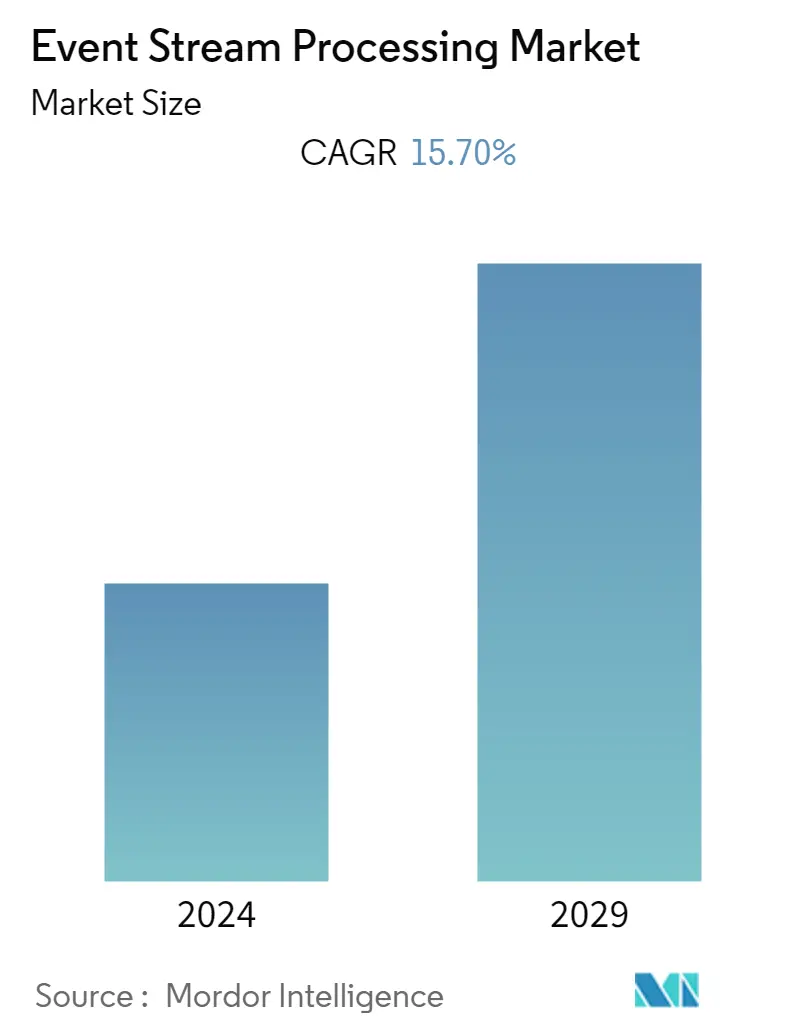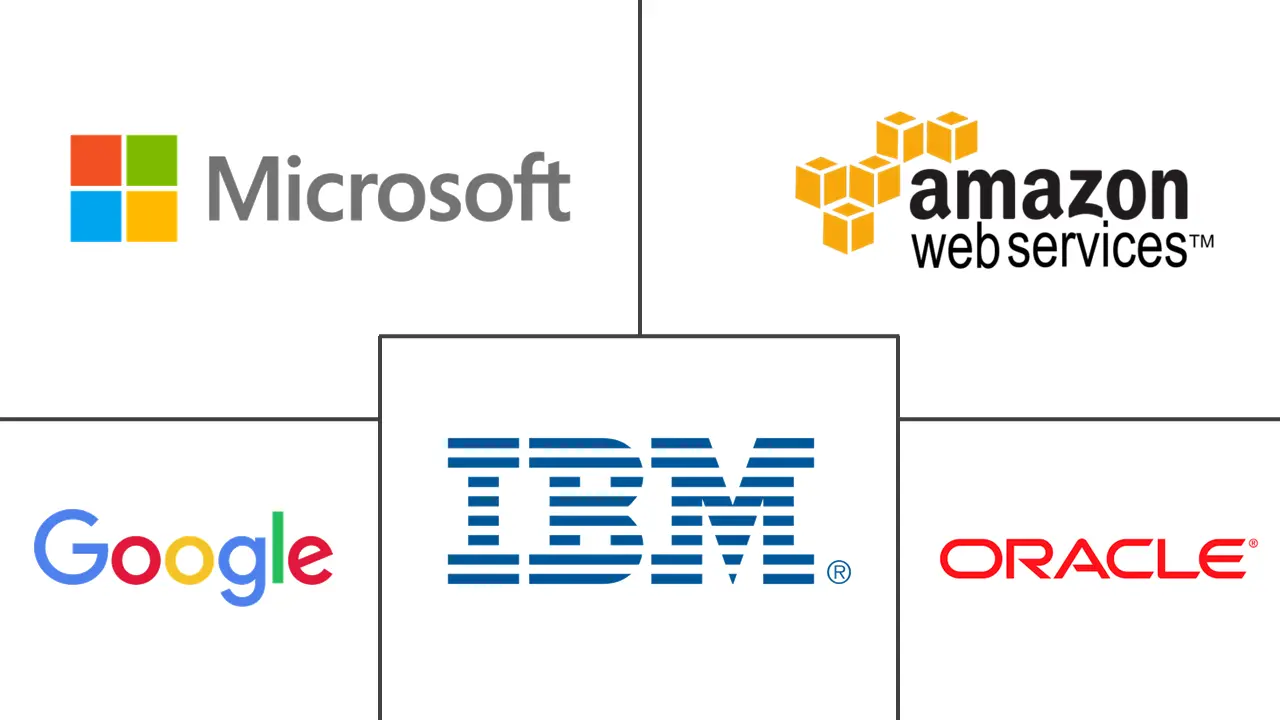Market Size of Event Stream Processing Industry

| Study Period | 2019 - 2029 |
| Base Year For Estimation | 2023 |
| CAGR | 15.70 % |
| Fastest Growing Market | Asia-Pacific |
| Largest Market | North America |
| Market Concentration | Medium |
Major Players
*Disclaimer: Major Players sorted in no particular order |
Event Stream Processing Market Analysis
The Event Stream Processing (ESP) market is expected to witness a CAGR of 15.7% over the forecast period. This market's expansion can be attributed to rising demand for real-time analytics and increased awareness of big data's benefits across sectors. During the forecast period, the growth of the market is also expected to be helped by the growing use of cloud-based event stream processing solutions.
- According to MachEye, people produce 2.5 quintillion bytes of data daily, which is expected to grow faster each year. Business intelligence users are already struggling to translate this explosion of complex data into actionable insights. As a result, there would be a significant demand for more advanced, easy-to-use data translation tools.
- Targeted offers and predictive analytics enable merchants to develop highly personalized offers for all their customers at a very granular level. For instance, retailers can personalize the in-store experience by providing offers to incentivize frequent buying and drive more purchases, thereby achieving higher sales across all their channels. Predictive analytics can be used to upsell or cross-sell a customer. Further, predictive analytics helps businesses predict a customer's lifetime value (CLV). CLV helps forecast a customer's discounted value over time by analyzing past behavior to determine the most profitable customers over time.
- Further, due to the necessity for real-time processing of vast volumes of RFID data, the use of event stream processing in radio-frequency identification (RFID) event processing applications is quickly rising. RFID tags are connected to items or people and generate a signal that an RFID reader can read. This lets businesses keep track of where goods and people are in real time, which is important for many things like managing the supply chain and keeping people safe.
- According to a survey from Sisense, 50% of companies are utilizing predictive analytics more or much more than before the COVID-19 pandemic, including over 68% of small businesses. For instance, a significant challenge of the COVID-19 pandemic was ensuring that clients felt safe when visiting brick-and-mortar stores. With the help of business intelligence tools, social networking platforms, and customer relationship management (CRM) systems, companies could get direct feedback from customers and take the right steps to ensure everyone's health and safety.
- There is a significant increase in the requirement for data analytics and data visualization tools. For example, according to the IBM Quant Crunch, up to 2.72 million jobs require data science skills, making it one of the most in-demand roles across industries. College graduates from the MIS and CS departments know little about database modeling or real-world database environments. There are specific IT sciences majors with database classes, let alone business intelligence and analytics courses. There is a lack of exposure to tools and technologies found in the workplace.
Event Stream Processing Industry Segmentation
Event stream processing (ESP) is a computer programming approach for detecting, responding to, and transforming information streams (event streams) as they happen. ESP can process data in real-time as it arrives or in near-real time with a little delay.
The Event Stream Processing Market is segmented by Deployment Type (Cloud, On-premise), Component (Solutions, Services), Application (Fraud Detection, Algorithmic Trading, Process Monitoring, Predictive Maintenance, Sales, and Marketing), End-user Vertical (IT & Telecommunications, BFSI, Manufacturing, Retail & E-commerce, Energy & Utilities), and Geography (North America, Europe, Asia Pacific, Latin America, the Middle East, and Africa).
The market sizes and forecasts are provided in terms of value (USD million) for all the above segments.
| Deployment Type | |
| Cloud | |
| On-premise |
| Component | |
| Solutions (Software & Platforms) | |
| Services |
| Application** | |
| Fraud Detection | |
| Algorithmic Trading | |
| Process Monitoring | |
| Predictive Maintenance | |
| Sales and Marketing |
| End-user Vertical | |
| IT & Telecommunications | |
| BFSI | |
| Manufacturing | |
| Retail & E-commerce | |
| Energy & Utilities | |
| Other End-user Verticals |
| Geography | |
| North America | |
| Europe | |
| Asia-Pacific | |
| Latin America | |
| Middle-East and Africa |
Event Stream Processing Market Size Summary
The Event Stream Processing (ESP) market is poised for significant growth, driven by the increasing demand for real-time analytics and the growing recognition of big data's advantages across various industries. The adoption of cloud-based ESP solutions is further propelling market expansion. As businesses grapple with the vast amounts of data generated daily, there is a pressing need for advanced tools that can translate complex data into actionable insights. This demand is particularly evident in sectors like retail, where predictive analytics and targeted offers are enhancing customer personalization and driving sales. Additionally, the rise of RFID technology is boosting the use of ESP in real-time data processing applications, crucial for supply chain management and safety.
North America is expected to dominate the ESP market, supported by a robust presence of vendors and substantial investments in research and development. The region's early adoption of new technologies and high adoption rates are key factors in its market leadership. Companies are increasingly offering innovative solutions to capture market share, with significant developments in cloud-based services and partnerships enhancing operational analytics. The market is moderately competitive, with major players like IBM, Microsoft, and Google actively engaging in product innovation and strategic collaborations to expand their offerings and maintain competitiveness. As digital transformation accelerates, the ESP market is set to experience continued growth, driven by the need for efficient data processing and real-time insights.
Event Stream Processing Market Size - Table of Contents
-
1. MARKET DYNAMICS
-
1.1 Market Overview
-
1.2 Market Drivers
-
1.2.1 Increasing Adoption of the Internet of Things (IoT) and Smart Devices
-
1.2.2 Increasing Need to Analyze Large Volumes of Data From Diverse Sources
-
-
1.3 Market Restraints
-
1.3.1 Concerns Associated with Data Security and Privacy
-
-
1.4 Porter's Five Forces Analysis
-
1.4.1 Bargaining Power of Suppliers
-
1.4.2 Bargaining Power of Buyers
-
1.4.3 Threat of New Entrants
-
1.4.4 Threat of Substitute Products
-
1.4.5 Intensity of Competitive Rivalry
-
-
-
2. MARKET SEGMENTATION
-
2.1 Deployment Type
-
2.1.1 Cloud
-
2.1.2 On-premise
-
-
2.2 Component
-
2.2.1 Solutions (Software & Platforms)
-
2.2.2 Services
-
-
2.3 Application**
-
2.3.1 Fraud Detection
-
2.3.2 Algorithmic Trading
-
2.3.3 Process Monitoring
-
2.3.4 Predictive Maintenance
-
2.3.5 Sales and Marketing
-
-
2.4 End-user Vertical
-
2.4.1 IT & Telecommunications
-
2.4.2 BFSI
-
2.4.3 Manufacturing
-
2.4.4 Retail & E-commerce
-
2.4.5 Energy & Utilities
-
2.4.6 Other End-user Verticals
-
-
2.5 Geography
-
2.5.1 North America
-
2.5.2 Europe
-
2.5.3 Asia-Pacific
-
2.5.4 Latin America
-
2.5.5 Middle-East and Africa
-
-
Event Stream Processing Market Size FAQs
What is the current Event Stream Processing Market size?
The Event Stream Processing Market is projected to register a CAGR of 15.70% during the forecast period (2024-2029)
Who are the key players in Event Stream Processing Market?
IBM Corporation, Microsoft Corporation, Google Inc., Oracle Corporation and Amazon Web Services Inc. are the major companies operating in the Event Stream Processing Market.

